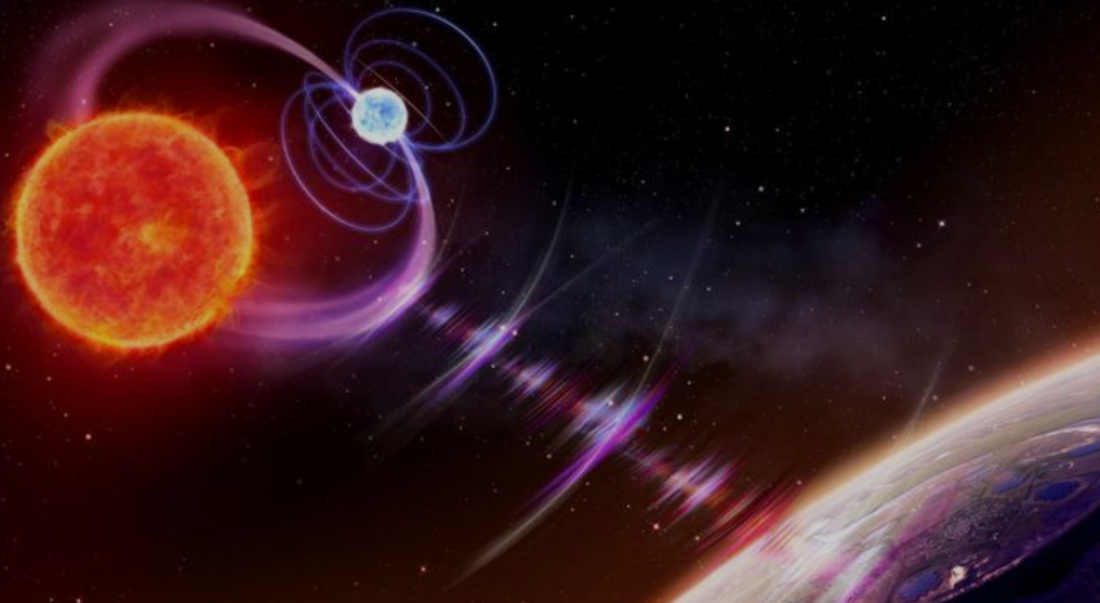live Trump says Ukraine peace talks ‘very close’ after Florida meeting with Zelenskyy
U.S. President Donald Trump said on Sunday that negotiations with Ukrainian President Volodymyr Zelenskyy to end the Russia-Ukraine war were “gettin...
For years, astronomers have been picking up strange bursts of energy from the cosmos — signals that last just milliseconds yet carry more power than the Sun releases in days. These puzzling flashes, known as fast radio bursts (FRBs), have become one of the greatest unsolved mysteries in astronomy.
What exactly are FRBs?
Fast radio bursts are ultra-bright pulses of radio waves that appear suddenly and then vanish. Some flare only once, while others repeat at irregular intervals.
The first FRB was detected in 2007 in archived telescope data from Australia. Since then, thousands more have been observed, but their origins remain elusive.
“It’s like someone is flicking a cosmic light switch on and off,” said Duncan Lorimer, the astrophysicist who first described the phenomenon. “But we don’t know who — or what — is behind it.”
Why are they so baffling?
Each FRB unleashes as much energy in a fraction of a second as 500 million Suns. “The sheer intensity is staggering,” noted Harvard astronomer Avi Loeb. “Whatever produces them must be among the most powerful engines in the universe.”
Pinpointing the origins is difficult. Some FRBs come from billions of light-years away, scattered across the universe. Theories include magnetars (super-magnetic neutron stars), collapsing stars, black holes colliding, and in the more speculative camp, even advanced alien technology.
While most bursts are one-offs, some repeat with odd rhythms. One discovered in 2020 emitted bursts every 16 days. “It’s like hearing a drumbeat from space,” said Kenzie Nimmo, an FRB researcher. “But the drummer is invisible.”
On their way to Earth, FRBs travel through cosmic gas, plasma and magnetic fields that bend and smear the signals. By the time they arrive, they’re so warped that tracing them back to their precise birthplace is almost impossible.
What do scientists know so far?
Why it matters
Solving the FRB mystery could open a new window into the universe. They could reveal the secrets of dark matter, measure how fast the universe is expanding, or uncover unknown forms of physics.
“Every time we think we’ve got it figured out, the universe throws us a curveball,” said Shami Chatterjee of Cornell University. “That’s what makes FRBs so exciting, they constantly defy expectations.”

The bottom line
Fast radio bursts are not proof of alien life, but they’re not fully explained by current science either. They sit in the tantalising gap between known physics and the unknown.
Whether they’re the work of collapsing stars, hyper-magnetised neutron stars, or something humanity has yet to imagine, FRBs remind us that the universe is still full of mysteries, and that sometimes, the cosmos whispers in bursts of static across the stars.
New York placed the state under emergency measures on Friday as a powerful winter storm brought the heaviest snowfall since 2022, disrupting travel across the north-east of the United States.
A 7.0 magnitude earthquake struck offshore near Taiwan’s north-eastern county of Yilan late on Saturday, shaking buildings across the island, including in the capital Taipei, authorities said.
Brigitte Bardot, the French actress whose barefoot mambo in And God Created Woman propelled her to international fame and reshaped female sexuality on screen, has died at the age of 91, her foundation said on Sunday.
Iran is engaged in a “comprehensive war” with the United States, Israel, and Europe, Iranian President Masoud Pezeshkian stated on Saturday.
Japan’s tourism sector has experienced a slowdown after China’s government advised its citizens to reconsider travel to Japan, following remarks by Prime Minister Sanae Takaichi regarding Taiwan.
North Korean leader Kim Jong Un oversaw the launch of long-range strategic cruise missiles on Sunday, in what state media described as a test confirming the country’s nuclear deterrent and readiness to respond to security threats.
Venezuelan President Nicolás Maduro on Sunday praised the country’s armed forces as “invincible warriors” during a year-end ceremony honouring the Bolivarian National Armed Forces, held in the coastal city of La Guaira.
At least 13 people were killed when an Interoceanic Train carrying around 250 passengers derailed in southern Mexico, authorities said on Sunday.
Chinese Foreign Minister Wang Yi hosted Cambodian Foreign Minister Prak Sokhonn and Thai Foreign Minister Sihasak Phuangketkeow in Yunnan province on Sunday, following a ceasefire that ended nearly three weeks of clashes along the Cambodia-Thailand border.
More than 1,200 people have been newly displaced in Sudan’s South and North Kordofan states due to escalating insecurity, the International Organisation for Migration (IOM) reported on Sunday.
You can download the AnewZ application from Play Store and the App Store.

What is your opinion on this topic?
Leave the first comment